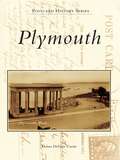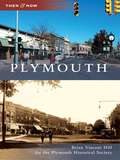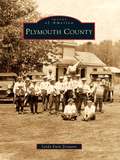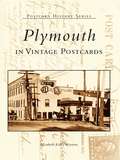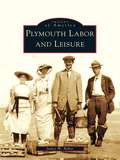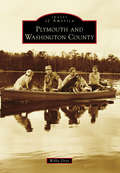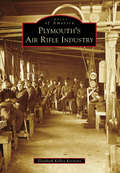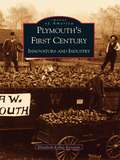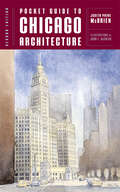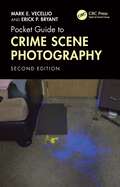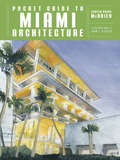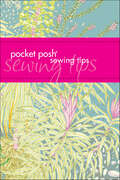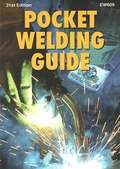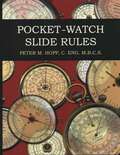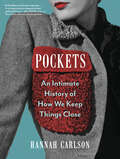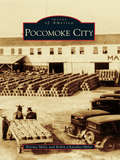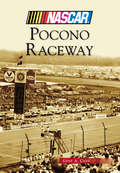- Table View
- List View
Plymouth (Postcard History)
by Donna Defabio CurtinPlymouth, famous as the landing place of the Pilgrims in 1620, conjures images of quaintly clad settlers, the first Thanksgiving, and Plymouth Rock. Known as "America's Hometown," Plymouth is the nation's longest enduring English settlement, still thriving four centuries after its founding. In the 19th century, Plymouth became an industrial center with the largest rope-making factory in the world. Immigrant workers revitalized the old Yankee town, making its modern character as much blue collar as blue blood. A developing Plymouth embraced its past, erecting monuments to the Pilgrims and highlighting sites like Burial Hill and Pilgrim Hall. The town became a major destination in the 20th century, attracting tourists and seasonal residents with its antiquity and scenic beauty. From picturesque to gritty, encounter more than the Pilgrims in this postcard history of Plymouth, featuring early-20th-century souvenir views.
Plymouth (Then and Now)
by Brian Vincent Hill Plymouth Historical SocietyAs the home to Native American encounters, rugged pioneers, governors, state legislators, founders of political parties, landmark legal decisions, multimillionaires, scandals, patents, and the largest international business of its kind, Plymouth has certainly received its 15 minutes of fame. Yet most citizens of Plymouth today only know it as a wonderful community full of parks, subdivisions, and a quaint Norman Rockwell-like downtown.
Plymouth County (Images of America)
by Linda Ewin ZiemannPlymouth County is one of the largest counties in Iowa, claiming 864 square miles. The early pioneers made this observation: "If you stared long enough at the open prairie, it would stare back at you!" The first white settlers arrived in 1856 and began establishing the communities of Westfield and Melbourne that same year. The town of Le Mars was founded in 1869. The town name was derived from the first initials of five women who visited the site with a railroad official. The early pioneers endured hardships and disappointments. They were committed to a way of life, forging ahead to make a better life for themselves, their children, and their grandchildren. Plymouth County portrays an overview of the county's history in early photographs.
Plymouth In Vintage Postcards (Postcard History)
by Elizabeth Kelley KerstensAs introduced in the book Plymouth's First Century: Innovators and Industry, more than 175 years of hard work, modernization, patriotism, and development have contributed to the vivid tapestry of the Plymouth community. This volume, comprised of vintage photo postcards, documents the businesses, people, activities, structures, and streets that have shaped Plymouth's rich history. From the legendary Daisy Manufacturing Company to present-day traditions like the Plymouth International Ice Spectacular, these remarkable images of Plymouth's historic people and places will continue to enlighten readers for generations to come.
Plymouth Labor and Leisure (Images of America)
by James W. BakerPlymouth is best known as the destination of the Mayflower. The Pilgrims, their heirs, and more recent immigrants spent their lives here as farmers, fishermen, shopkeepers, and factory workers. Industries such as the Plymouth Cordage Company, Puritan Mills, Mabbett's, and Russell Mills built communities that are in danger of being forgotten today. Plymouth Labor and Leisure revisits the industrial history of this town through images of Plymouth's people at work in the mills and in corner grocery stores, visiting downtown shops, and attending neighborhood schools.
Plymouth and Washington County (Images of America)
by Willie DryePlymouth and Washington County, North Carolina, are entwined with the beginnings of American history. The area surrounding the Albemarle Sound was the birthplace of North Carolina. Plymouth began as a 17th-century trading post on the Roanoke River, which empties into the sound. When the nearby Dismal Swamp Canal opened in 1805, Plymouth was linked to the deepwater harbor of Norfolk, Virginia, and quickly grew into one of North Carolina's busiest ports. With the outbreak of the Civil War in 1861, young men from Washington County enlisted in both the Union and Confederate armies, and Plymouth was the scene of fierce fighting throughout the conflict. Today, Plymouth and Washington County attract visitors eager to enjoy boating, bass fishing, and bird-watching in an unspoiled coastal wilderness; visit Civil War sites; or absorb the fascinating maritime history.
Plymouth's Air Rifle Industry (Images of America)
by Elizabeth Kelley KerstensIn the late 19th century, the Rockwellian city of Plymouth, Michigan, became the breeding ground for competitive air-rifle companies, putting this still-thriving suburban Detroit community on the map. Plymouth's Air Rifle Industry hones in on the three air-rifle companies and the spin-off .22-caliber rifle company that dominated the Plymouth landscape for years. William "Philip" Markham and his company, the Markham Air Rifle Company, first received an air-rifle patent in 1887. The Plymouth Iron Windmill Company entered the competition in 1888, when founder Clarence Hamilton introduced his prototype to the board of directors. After firing the rifle, general manager Lewis Cass Hough declared, "Boy, that's a Daisy," and the Daisy air rifle was born; the company was renamed in 1895. The Plymouth Air Rifle Company opened in 1888 and ceased to exist after its building burned in 1894. Hamilton went on to develop a .22-caliber rifle and started the Hamilton Manufacturing Company in 1898. The rifle era ended when the last of the competitors, Daisy, moved to Rogers, Arkansas, in 1958.
Plymouth's First Century: Innovators and Industry (Images of America)
by Elizabeth Kelley KerstensThe year 2002 marks the 175th anniversary of the founding of Plymouth Township in Michigan Territory. The first settlers were true pioneers, carving a living out of the wilderness and working together to establish a community. Farms and farmers were the backbone of the community until after the Civil War when two railroads intersected in the Village of Plymouth. The railroads brought many opportunities to the area, and helped spread the products invented by an innovative population.Plymouth, Michigan's First Century: Innovators and Industry contains more than 200 images from the Plymouth Historical Museum and from the collections of some of Plymouth's current residents. You'll see the township blossom from farms and mills to a cohesive community of inventors and patriots. Early images of the main business block of Plymouth Village are reminiscent of the Wild West; later images depict a vibrant community, as it remains today.
Plymouth, Connecticut (Images of America)
by Lani B. JohnsonDuring the seventeenth and eighteenth centuries, the town of Plymouth, Connecticut--formerly known as Northbury--was settled only by scattered groups of Indians and hearty newcomers from Europe. As time went on, however, the Town of Plymouth developed into an industrial community composed of nine organized districts: Plymouth, Greystone, Allentown, the Lakes, Pequabuck, Terryville, East Plymouth, and the Holt District. Residents of Plymouth were industrious and inventive from the very beginning. In 1793 Eli Terry founded the clock-making business that became the foremost enterprise in the town's history, and in 1854 the expansion of the Eagle Lock Company fostered the development of Terryville. During the course of the nineteenth century, a plethora of smaller companies developed along the town's many waterways, manufacturing everything from furniture to toys, plows, and hats. Plymouth, Connecticut chronicles the development of the town through the years with a remarkable series of vintage images and informative text.
Po' Monkey's: Portrait of a Juke Joint
by Will JacksOutside of Merigold, Mississippi, off an unmarked dirt road, stands Po’ Monkey’s, perhaps the most famous house in Mississippi and the last rural juke joint in the state, now closed to the public. Before the death of the lounge’s owner, Willie Seaberry, in 2016, it was a mandatory stop on the constant blues pilgrimage that flows through the Delta. Seaberry ran Po’ Monkey’s Lounge for more than fifty years, opening his juke joint in the 1960s. A hand-built tenant home located on the plantation where Seaberry worked, Po’ Monkey’s was a place to listen to music and drink beer—a place to relax where everyone was welcomed by Seaberry’s infectious charm. In Po’ Monkey’s: Portrait of a Juke Joint, photographer Will Jacks captures the juke joint he spent a decade patronizing. The more than seventy black-and-white photographs featured in this volume reflect ten years of weekly visits to the lounge as a regular—a journal of Jacks’s encounters with other customers, tourists, and Willie Seaberry himself. An essay by award-winning writer Boyce Upholt on the cultural significance of the lounge accompanies the images. This volume explores the difficulties of preservation, historical context, community relations, and cultural tourism. Now that Seaberry is gone, the uncertainty of the future of his juke joint highlights the need for a historical record.
Pocket Bios: Charlie Chaplin (Pocket Bios)
by Al BerengerA colorfully illustrated, pocket-size picture book biography of actor and silent film legend Charlie Chaplin.Charlie Chaplin, renowned comic silent film icon, enjoyed a successful seventy-five year career as an actor, filmmaker, and composer. Born into a life of poverty and hardship in London, he began working before he was nine years old and rose quickly to fame for his persona "the Tramp." One of the best known figures in the world during his heyday, Chaplin is still famous today for his myriad of iconic silent film roles.Pocket Bios are full of personality, introducing readers to fascinating figures from history with simple storytelling and cheerful illustrations. Titles include men and women from history, exploration, the sciences, the arts, the ancient world, and more.
Pocket Bios: Frida Kahlo (Pocket Bios)
by Al BerengerFrida Kahlo remains one of the most celebrated painters of her time for her exploration of themes of feminism, gender, class, and race in her artwork and frequent self-portraits. From her childhood struggle with polio, to the traffic accident that left her with chronic pain, to her artistic exploration of herself and her identity, follow this extraordinary woman's life and accomplishments.Pocket Bios are full of personality, introducing readers to fascinating figures from history with simple storytelling and cheerful illustrations. Titles include men and women from history, exploration, the sciences, the arts, the ancient world, and more.
Pocket Bios: Pablo Picasso (Pocket Bios)
by Al BerengerA colorfully illustrated, pocket-size picture book biography of famed artist Pablo Picasso.Pablo Picasso was co-founder of the Cubist movement, and an inventor of art forms such as constructed sculpture and collage. An extremely prolific and multi-faceted artist, he produced a wide variety of extraordinary artworks throughout his long lifetime, including the Guernica and The Young Ladies of Avignon oil paintings. His creative, revolutionary style continues to mesmerize the world to this day, and he is one of the most influential and universally renowned artists of the 20th century.About the Pocket Bios series: Pocket Bios are full of personality, introducing readers to fascinating figures from history with simple storytelling and cheerful illustrations. Titles include men and women from history, exploration, the sciences, the arts, the ancient world, and more.Love art? Don't miss the Pocket Bios about Frida Kahlo and Vincent van Gogh.
Pocket Guide to Chicago Architecture (Norton Pocket Guides #0)
by Judith Paine McBrien“A handy guidebook that profiles a building per page, with a drawing and vital statistics on most of Chicago’s major historic and modern buildings.”—Chicago Tribune Updated and expanded to chart the changing urban landscape of Chicago--as well as to incorporate a section on Chicago’s campus architecture, including works by Rem Koolhaas at the Illinois Institute of Technology and Frank Lloyd Wright at the University of Chicago--the second edition of this popular handbook is a perfect companion for walking tours and an excellent source of background information for exploring the internationally acclaimed architecture of Chicago. Over 100 highlights of downtown Chicago are covered, from Michigan Avenue to the riverfront to the Loop, with accompanying maps, a glossary of architectural terms, and an index of architects and buildings.
Pocket Guide to Collecting Movies on DVD
by Steven H. Scheuer Alida Brill-ScheuerCitizen Kane Boogie Nights Sunset Boulevard My Fair Lady Almost Famous Jaws A Hard Day's Night Lord of the Rings Monsoon Wedding Apocalypse Now Redux Moulin Rouge Butch Cassidy and the Sundance Kid A Beautiful Mind Shakespeare in Love THEY'RE NOT JUST MOVIES ANYMORE. THEY'RE DVDs. Supplements...special collector's edition...extras...Words that set the heart pounding of every DVD lover. But how do you decide which DVDs to buy? Where do you begin collecting? Which special features are really special? What commentaries are informative or entertaining? Which disks are worth your time and money? Here at last is the portable, one-of-a-kind DVD buyer's guide -- from veteran film and television critics Steven H. Scheuer and Alida Brill-Scheuer. Director/star/crew audio commentaries Outtakes Filmographies and biographies Alternate takes, music, and endings Celebrity interviews Deleted scenes Trailers Lost footage Hidden features and Easter eggs Animated menus Production notes Storyboards Promotional art DVD-rom extras Behind-the-scenes footage Screenplays Souvenir booklets and a special afterword on the best DVDs for kids
Pocket Guide to Crime Scene Photography
by Mark E. Vecellio Erick P. BryantThere are more than 800,000 sworn law enforcement officers employed within the United States, many of whom are regularly tasked with photographing crime scenes or evidence associated with criminal investigations. Despite this fact, law enforcement personnel—including detectives and crime scene investigators—frequently receive little to no formal training in the art and science of photography, let alone for capturing photographic evidence for forensic casework and future legal proceedings. Unlike other resources on the topic that often contain overly complicated or rife with unnecessary or confusing technical jargon—this edition of Pocket Guide to Crime Scene Photography follows in the tradition of the first. The book is wholly updated, based on best practices and advances in camera technology to provide a practical, streamlined approach guide to the photographic documentation of crime scenes and physical evidence. The coverage includes extensive illustrations with two completely new chapters. The first focuses on specialized instructions for photographing shooting incident scenes, bloodstains, and evidence, made visible through infrared light; the is second dedicated to offering advice for photographing crime scenes and evidence with mobile device cameras.Chapters distill the technical jargon and complex processes of photographing crime scenes and evidence into straightforward step-by-step descriptions. Pocket Guide to Crime Scene Photography, Second Edition has been designed in a smaller, handy trim size as a convenient, portable tool to help busy professionals. Its techniques include practical guidelines that can be immediately implemented by law enforcement personnel to maximize their time and improve their skills.Features: Provides an up-to-date, portable reference ideal for use in the field; includes full-color photographs throughout to illustrate key concepts Details how to document various types of evidence, and crime scenes, using both standard and specialized techniques Outlines visualization and photography of evidence—illuminated with alternative light sources—including visible wavelengths, UV, and infrared Presents guidance for personnel who might only be able to use cell phone cameras for photographing evidence and scenes Written by two experienced professionals who know the investigative and courtroom requirements for quality admissible photos.
Pocket Guide to Miami Architecture (Norton Pocket Guides)
by John F. Desalvo Judith Paine McbrienThis guidebook organizes 100 architectural highlights into walkable tours in downtown Miami and Miami Beach. From the tropical vernacular of the Barnacle House to the Art Deco neighborhoods of Miami Beach, from the Midcentury Modernism of Morris Lapidus to the sophisticated rhythms of Arquitectonica, Judith Paine McBrien captures the vibrancy and diversity of architecture in Miami and its environs. Set in a stunning seaside site, the buildings of Miami, Miami Beach, Coral Gables, and Coconut Grove tell a fascinating story of artifice, innovation, charm, and international influence. This masterfully illustrated guide highlights the buildings that visitors will want to see, among them the City Beautiful planning of Coral Gables; the classical glory of Vizcaya; and the New World Symphony, Frank Gehry's twenty-first-century reinterpretation of the music hall.
Pocket Pal: A Graphic Arts Production Handbook, Twentieth Edition
by Frank RomanoPocket Pal is an authoritative introduction to the graphic arts. It is useful for artists, graphic designers, publishers, advertisers, students, and buyers of printing. Covers topics on prepress graphic arts and subjects include digital printing and papers. This book is a unique and welcome gift idea for anyone interested in printing.
Pocket Posh Sewing Tips
by Jodie DavisThe latest addition to the multi-million-selling Pocket Posh series, this gorgeous, handy reference guide can be carried in bags, totes, or purses. An irresistible, eye-catching package of tips and tricks for seasoned sewers and novices, too, Pocket Posh Sewing Tips offers a gorgeous, on-the-go reference guide. Perfect for all levels, this accessible reference offers concise instructions for basic and advanced sewing techniques, guidance on choosing tools and fabrics, fabric decoration ideas, tips for achieving a perfect finish, plus the usual plethora of helpful hints, expert advice, and insider secrets for flawless sewing.
Pocket Shop Reference
by Tom BegnalYour personal research assistant Anyone who works wood knows that the craft veers into math, biology and chemistry. You often have to compute some odd joint angle, calculate the amount of wood movement in a panel, choose appropriate metal hardware, or select the proper adhesive or finish for the job at hand, to name just a few examples. Fortunately, you no longer have to spend hours laboring over magazines and books for this kind of information. A quick look at the table of contents in this little compendium shows that it's crammed with exactly the kind of answers a woodworker needs to have on hand. It includes common geometry equations, math conversion tables, standard furniture dimensions, shelf load limit charts, a glossary of joints, properties of various woods, adhesives, finishes, and lots more. The best thing is that all the information is at your fingertips and easy to find, making this one of the hardest working little shop helpers you could hope to have.
Pocket Welding Guide: A Guide to Better Welding (31st Edition)
by Hobart Institute of Welding TechnologyPocket welding guide is dedicated to all those who are interested in and work with any aspect of welding. It covers a wide variety of subjects that are essential for the student or beginner and are of interest to the veteran welders, technicians, and engineers.
Pocket-Watch Slide Rules
by Peter M. HoppThis book is about one of the most attractive and tactile forms of slide rules, the pocket-watch slide rule. Although pocket-watch slide rules were not the most accurate nor easiest to use, these delightful devices were featured in makers catalogues from all parts of the world for the last century of the slide rule s life. Pocket-watch slide rules are an exquisite example of the slide rule makers art and are perhaps the most collectible type of slide rules. The Book Includes: -Descriptions of over 150 pocket-watch slide rules and variants -Full-color illustrations, detailed descriptions, and dating information -Approximately 80 makers and retailers from the UK, Europe, and the USA -Descriptions of special scales used -Coverage of seminal patents -A glossary of terms -A comprehensive bibliography
Pockets: An Intimate History of How We Keep Things Close
by Hannah Carlson&“Who knew the humble pocket could hold so much history? In this enthralling and always surprising account, Hannah Carlson turns the pocket inside out and out tumble pocket watches, coins, pistols, and a riveting centuries-long social and political history.&” ―Jill Lepore, author of These Truths: A History of the United StatesPockets "showcases the best features of cultural history: a lively combination of visual, literary and documentary evidence. As sumptuously illustrated as it is learned … this highly inventive and original book demands a pocket sequel.&” ―Jane Kamensky, Wall Street Journal Who gets pockets, and why? It&’s a subject that stirs up plenty of passion: Why do men&’s clothes have so many pockets and women&’s so few? And why are the pockets on women&’s clothes often too small to fit phones, if they even open at all? In her captivating book, Hannah Carlson, a lecturer in dress history at the Rhode Island School of Design, reveals the issues of gender politics, security, sexuality, power, and privilege tucked inside our pockets. Throughout the medieval era in Europe, the purse was an almost universal dress feature. But when tailors stitched the first pockets into men&’s trousers five hundred years ago, it ignited controversy and introduced a range of social issues that we continue to wrestle with today, from concealed pistols to gender inequality. See: #GiveMePocketsOrGiveMeDeath. Filled with incredible images, this microhistory of the humble pocket uncovers what pockets tell us about ourselves: How is it that putting your hands in your pockets can be seen as a sign of laziness, arrogance, confidence, or perversion? Walt Whitman&’s author photograph, hand in pocket, for Leaves of Grass seemed like an affront to middle-class respectability. When W.E.B. Du Bois posed for a portrait, his pocketed hands signaled defiant coolness. And what else might be hiding in the history of our pockets? (There&’s a reason that the contents of Abraham Lincoln&’s pockets are the most popular exhibit at the Library of Congress.) Thinking about the future, Carlson asks whether we will still want pockets when our clothes contain &“smart&” textiles that incorporate our IDs and credit cards.Pockets is for the legions of people obsessed with pockets and their absence, and for anyone interested in how our clothes influence the way we navigate the world.
Pocomoke City
by Norma Miles Robin Chandler-MilesIn 1670, Lord Baltimore sent his representative, Col. William Stevens, to claim and develop land in rural Maryland. He established a ferry crossing along the banks of the deep, dark Pocomoke River, and the settlement that would eventually become Pocomoke City was born. Trade flourished; boats filled with lumber, tobacco, and furs sailed on the river to Northern ports, and shipbuilding became a successful enterprise. People flocked to Pocomoke City to work at the lumber mills and in the shipyards, and the little town grew into a small center of commerce with the coming of the Pennsylvania Railroad. In 1922, a devastating fire destroyed 75 percent of the business section of the town, but the community came together and rebuilt what has been called "the Friendliest Town on the Eastern Shore."
Pocono Raceway
by Gene A. CardThe framework for the creation of Pocono Raceway began in the late 1950s, when a group of investors formed Racing Incorporated. In 1962, a spinach farm near Long Pond, Pennsylvania, was chosen as the site for the multifaceted racing complex. Construction on the track began in 1965, but progress moved very slowly. The three-quarter-mile oval portion of the facility was completed in 1968, but it was not until 1971 that the two-and-a-half-mile superspeedway was ready for competition. From its humble beginnings, Pocono Raceway has grown to attract great numbers of enthusiastic spectators to both of its NASCAR® events each year.
